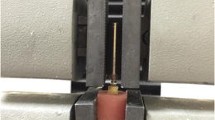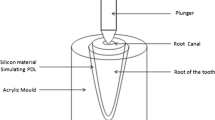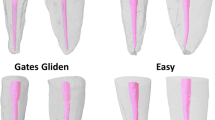Abstract
Purpose
The purpose of the present study was to examine how the various resection methods effect the root fracture resistance of the endodontic surgery.
Methods
A test for the fracture resistance was performed using forty extracted human teeth. The root canals were prepared with rotary instruments and obturated with cold lateral compaction of gutta percha + root canal sealer. Apical 3-mm portions of the roots were resected. While all roots were divided into three experimental groups, 10 roots were used for the control group. Retrograde cavities were prepared using slow-speed tungsten carbide round burs, ultrasonic retrotips, and Er,Cr:YSGG laser. All cavities were restored with MTA. Roots were embedded in acrylic resin-filled cylindrical molds until 2 mm beneath the cementoenamel junction. The force with a speed of 1 mm/min was applied vertically along the long axis of the tooth. Then, the highest fracture resistance of each tooth was measured in Newtons. The recorded data were statistically analyzed with one-way ANOVA and post hoc Tukey tests.
Results
According to the results, there was no statistically significant difference among the groups (p > 0.05).
Conclusion
Root-end preparation methods had no effect on the fracture resistance of teeth.




Similar content being viewed by others
References
European Society of Endodontology (2006) Quality guidelines for endodontic treatment: consensus report of the European Society of Endodontology. Int Endod J 39:921–930
Torabinejad M, Higa RK, McKendry DJ, Pitt Ford TR (1994) Dye leakage of four root end filling materials: effects of blood contamination. J Endod 20:159–163
Cohen S, Burns RC (2002) Pathways of the pulp, 8th edn. C.V. Mosby, St. Louis, p 102
Von Arx T, Walker WA III (2000) Microsurgical instruments for root end cavity preparation following apicoectomy: a literature review. Endod Dent Traumatol 16:47–62
Wuchenich G, Meadows TM (1994) A comparison between two root end preparation techniques in human cadavers. J Endod 20:279–282
Carr GB (1997) Ultrasonic root end preparation. Dent Clin North Am 41:541–554
Yazdanfar I, Barekatain M, ZareJahromi M (2020) Combination effects of diode laser and resin-modified tricalcium silicate on direct pulp capping treatment of caries exposures in permanent teeth: a randomized clinical trial. Lasers Med Sci 35:1849–1855
Cheng X, Guan S, Lu H et al (2012) Evaluation of the bactericidal effect of Nd: YAG, Er: YAG, Er, Cr: YSGG laser radiation, and antimicrobial photodynamic therapy (aPDT) in experimentally infected root canals. Lasers Surg Med 44(10):824–831
Matsumoto K, Wang X, Zhang C, Kinoshita JI (2007) Effect of a novel Er: YAG laser in caries removal and cavity preparation: a clinical observation. Photomed Laser Ther 25(1):8–13
Mohammadi Z (2009) Laser applications in endodontics: an update review. Int Dent J 59(1):35–46
Araki ÂT, Ibraki Y, Kawakami T, Lage-Marques JL (2006) Er:YAG laser irradiation of the microbiological apical biofilm. Braz Dent J 17:296–299
Van As G (2004) Erbium Lasers in dentistry. Dental Clin North Am 48:1017–1059
Winik R, Araki AT, Negrão JA et al (2006) Sealer penetration and marginal permeability after apicoectomy varying retrocavity preparation and retrofilling material. Braz Dent J 17:323–327
Ishizaki NT, Matsumoto K, Kimura Y et al (2004) Thermographical and morphological studies of Er;Cr:YSGG laser irradiation on root canal walls. Photomed Laser Surg 22:291–297
Miller RJ (2004) Treatment of contaminated implant surfaces using the Er;Cr:YSGG laser. Implant Dent 13:165–170
Shetty D, Kailar A, Pare S et al (2020) The effect of root end cavity preparation using Er, Cr: YSGG laser, ultrasonic retrotip, and bur on the apical microleakage of retrograde cavity filled with MTA Plus. J Pharm Bioallied Sci 12(Suppl 1):299–303
Roghanizad N, Fekrazad R, Kalhori KA et al (2015) A comparison of Er, Cr: YSGG laser with ultrasonic preparation on the seal of retrograde cavities. Laser Ther 24(1):33–37
Negi S, Adhikari HD, Mazumder D et al (2019) Comparative evaluation of microleakage after root-end resection by erbium, chromium: yttrium-scandium-gallium-garnet (Er, Cr: YSGG) laser and carbide bur with or without placement of mineral trioxide aggregate: an in vitro study. J Conserv Dent 22(4):391–395
Koçak MM, Koçak S, Aktuna S et al (2011) Sealing ability of retrofilling materials following various root-end cavity preparation techniques. Lasers Med Sci 26:427–431
Angiero F, Benedicenti S, Signore A et al (2011) Apicoectomies with the erbium laser: a complementary technique for retrograde endodontic treatment. Photomed Laser Surg 29(12):845–849
Franco EJ, Greghi SLA, Assis GFD (2005) Comparative evaluation of periodontal radicular therapies-conventional and Er:YAG laser-based on rat connective tissue response. Oral Sci 2005:35–42
Wallace JA (2006) Effect of Waterlase laser retrograde root-end cavity preparation on the integrity of root apices of extracted teeth as demonstrated by light microscopy. Aust Endod J 32(1):35–39
Ayrancı F, Ayrancı LB, Özdoğan A et al (2018) Resistance to vertical root fracture of apicoected teeth using different devices during two root canal irrigation procedures. Lasers Med Sci 33:1685–1691
Gondim E, Zaia AA, Gomes BP et al (2003) Investigation of the marginal adaptation of root end filling materials in root end cavities prepared with ultrasonic tips. Int Endod J 36:491–499
Plotino G, Pameijer CH, Grande NM, Somma F (2007) Ultrasonics in endodontics: a review of the literature. J Endod 33(2):81–95
Shinkai K, Takada M, Kawashima S et al (2019) Effects of the percentage of air/water in spray on the efficiency of tooth ablation with erbium, chromium: yttrium-scandium-gallium-garnet (Er, Cr: YSGG) laser irradiation. Lasers Med Sci 34:99–105
Tidmarsh BG, Arrowsmith MG (1998) Dentinal tubules at the roots end of apicected teeth: a scanning electron microscopic study. Int Endod J 22:184–189
Gagliani M, Taschieri S, Molinari R (1998) Ultrasonic root-end preparation: influence of cutting angle on the apical seal. J Endod 24:726–730
Peters CI, Peters OA, Barbakow F (2001) An in vitro study comparing root-end cavities prepared by diamond-coated and stainless steel ultrasonic retrotips. Int Endod J 34:142–148
Kokate SR, Pawar AM (2012) An in vitro comparative stereomicroscopic evaluation of marginal seal between MTA, glass inomer cement & biodentine as root end filling materials using 1% methylene blue as tracer. Endod 24:36–42
Torabinejad M, Chivian N (1999) Clinical applications of mineral trioxide aggregate. J Endod 25:197–205
Kimura Y, Yu DG, Kinoshita JI et al (2001) Effects of erbium, chromium: YSGG laser irradiation on root surface: morphological and atomic analytical studies. J Clin Las Med Surg 19(2):69–72
Berbert FLCV, de Faria-Júnior NB, Tanomaru-Filho M et al (2010) An in vitro evaluation of apicoectomies and retropreparations using different methods. Oral Surg Oral Med Oral Pathol Oral Radiol Endod 110(4):e57–e63
Ayranci F, Ayranci LB, Arslan H et al (2015) Assessment of root surfaces of apicected teeth: a scanning electron microscopy evaluation. Niger J Clin Pract 18(2):198–202
de Faria-Junior NB, Tanomaru-Filho M, Guerreiro-Tanomaru JM et al (2009) Evaluation of ultrasonic and Er, Cr:YSGG laser retrograde cavity preparation. J Endod 35(5):741–744
Rahimi S, Yavari HR, Shahi S et al (2010) Comparison of the effect of Er, Cr-YSGG laser and ultrasonic retrograde root-end cavity preparation on the integrity of root apices. J Oral Sci 52:77–81
Aydemir S, Cimilli H, Mumcu G, Chandler N, Kartal N (2014) Crack formation on resected root surfaces subjected to conventional, ultrasonic, and laser root-end cavity preparation. Photomed Laser Surg 32:351–355
Romanos GE (2021) Advanced laser surgery in dentistry. John Wiley & Sons
Author information
Authors and Affiliations
Contributions
All the authors contributed to the study conception and design. Material preparation and data collection by Fatma Tunc and Mohammed Hussein and analyses were performed by Fatma Tunc. The first draft of the manuscript was written by Fatma Tunc and all the authors commented on previous versions of the manuscript. All the authors read and approved the final manuscript.
Corresponding author
Ethics declarations
Ethics approval
This study was performed in line with the principles of the Declaration of Helsinki. Approval was granted by the Ethics Committee of University Gaziantep (Code: 06.03.2019/386).
Informed consent
Informed consent was obtained from all individual participants included in the study.
Consent for publication
Not applicable.
Conflict of interests
The authors declare no competing interests.
Additional information
Publisher’s Note
Springer Nature remains neutral with regard to jurisdictional claims in published maps and institutional affiliations.
Rights and permissions
Springer Nature or its licensor (e.g. a society or other partner) holds exclusive rights to this article under a publishing agreement with the author(s) or other rightsholder(s); author self-archiving of the accepted manuscript version of this article is solely governed by the terms of such publishing agreement and applicable law.
About this article
Cite this article
Tunç, F., Hussein, M. Evaluation of different root-end cavity preparation techniques on root fracture resistance. Laser Dent Sci 7, 235–241 (2023). https://doi.org/10.1007/s41547-023-00202-4
Received:
Accepted:
Published:
Issue Date:
DOI: https://doi.org/10.1007/s41547-023-00202-4




